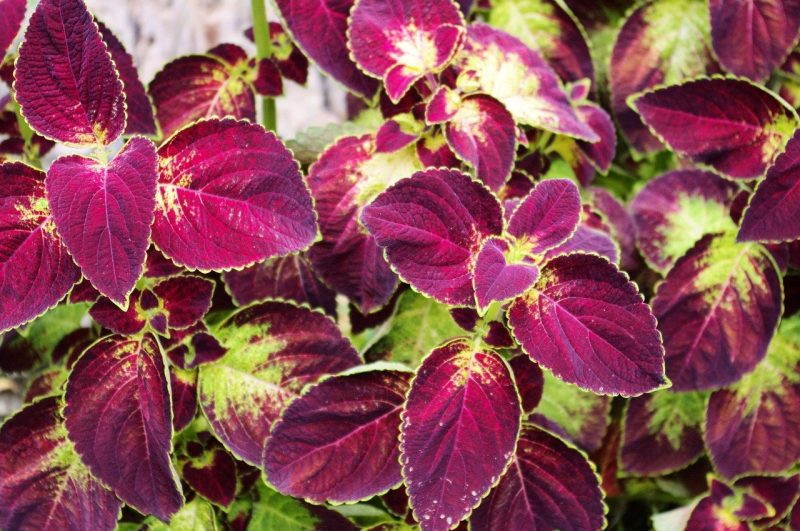Did you know that you can learn how to propagate coleus plants using two methods? This popular landscape plant is relatively easy to reproduce, and gardeners can choose to start from seeds or cuttings. You even have a headstart from the competition if you have a greenhouse for propagating coleus.
Remember that to encourage seed germination or to root cuttings, the conditions should be optimal. You can easily adjust the environment indoors and mimic the preferred growing conditions of coleus. This way, you can root coleus as quickly as possible for transplanting sooner as well.

How To Grow Coleus Plants
Method #1. Seeds
Step#1. Seed collection
The first propagation technique for growing coleus plants is by starting them from seeds. You can collect them yourself, but it should also be easy to find them in seed stores. However, note that unlike propagation from cuttings, starting coleus from seed won’t guarantee specific characteristics.
If you want to obtain coleus seeds from your plants, you can wait for the flowers to develop seed pods after they fade. Please wait for the pod to turn yellowish and let them dry before collecting the seeds. You can quickly gather the seeds by rubbing the pods, but don’t forget to remove the chaff by blowing on them afterward.
Step #2. Sowing
Once you have the seeds, you have the option to start them in the greenhouse or sow directly outdoors. It would be advantageous to sow coleus seeds indoors for optimal productivity. This way, you have enough time to grow vigorous plants for transplanting.
Indoors
Sow coleus seeds in the greenhouse eight weeks before your last frost to help them establish themselves. You can use a container with moist potting soil and spread the seeds evenly on the surface. And since the seeds are relatively tiny, spacing can be difficult, so thin the seedlings later on instead.
Cover them with soil lightly and maintain a humid environment by placing a plastic bag over the pot. Choose a bright and warm area in the greenhouse, but ensure that the seeds are not hit by direct sunlight. You can also adjust the indoor temperatures between 70 and 75°F for quicker germination.
Outdoors
On the other hand, you can sow coleus seeds directly in the garden if the soil is warm. However, this is only preferable after the danger of frost has passed or if you are in growing zones nine and warmer. Prepare the site to create a moist and fertile location before sowing the seeds thinly.
Maintain the moisture of the ground, and don’t forget to be mindful in protecting the seeds from challenging weather conditions like rain. One can expect coleus to germinate after one to two weeks, depending on the environment’s stability. However, it’s natural for the process to start slowly, even indoors.
Step #3. Maintenance
Once your seeds germinate, you can remove the cover but continue keeping the medium damp to support their growth. Just remember to water from below to avoid damaging the seedlings. Then, wait for the plants to grow two sets of true leaves and reach a height of almost three inches to indicate transplanting in larger containers.
Allocate one seedling per container and place them somewhere bright. It will also boost the coleus plants if you feed them every two weeks with a diluted fertilizer with plenty of nitrogen. A useful tip to have bushy coleus plants is pinching the top inch as well.
Method #2. Cuttings
Step #1. Taking cuttings
A more straightforward way to clone coleus is by using cuttings. Select an apical stem around six inches long and cut below a leaf node using sharp and sterile shears. Don’t forget to only take cuttings from a large, healthy, and mature plant to ensure quick recovery afterward.
Step #3. Preparation
Before rooting, you want to remove or pinch all the lower leaves on your cuttings. This way, they won’t get in contact with your chosen rooting medium nor compete with the nutrients for root development. Experienced gardeners also recommend dipping the end in rooting hormone to encourage faster root growth.
Step #4. Rooting
You have the option to root coleus cuttings either in soil or water. If you choose to root them in water, make sure that it reaches all the nodes but never the top leaves. On the other hand, place the cutting in a container with moist soil and cover it with plastic to create a humid environment.
Step #5. Maintenance
Place the cuttings somewhere bright but out of direct light for faster rooting. It can take the plants two to three weeks, and you can also place them in the greenhouse, so the conditions are stable. Always check the soil for dampness or replace your water as part of maintenance.
The Clemson Cooperative Extension recommends feeding from June to August to boost the flowering of coleus plants. However, it’s not advisable to use fertilizers that are high in phosphorus. These types of feeds can cause leggy growth in coleus plants.
Conclusion
Coleus plants are relatively easy to start and grow yourself. You have two options to learn how to propagate coleus plants, which are via seeds or cuttings. Both methods are straightforward, but the former is an excellent way to clone your favorites.
Consider propagating coleus indoors for optimal germination or rooting and then transplant outdoors after the danger of frost has passed.
